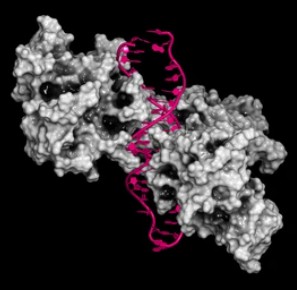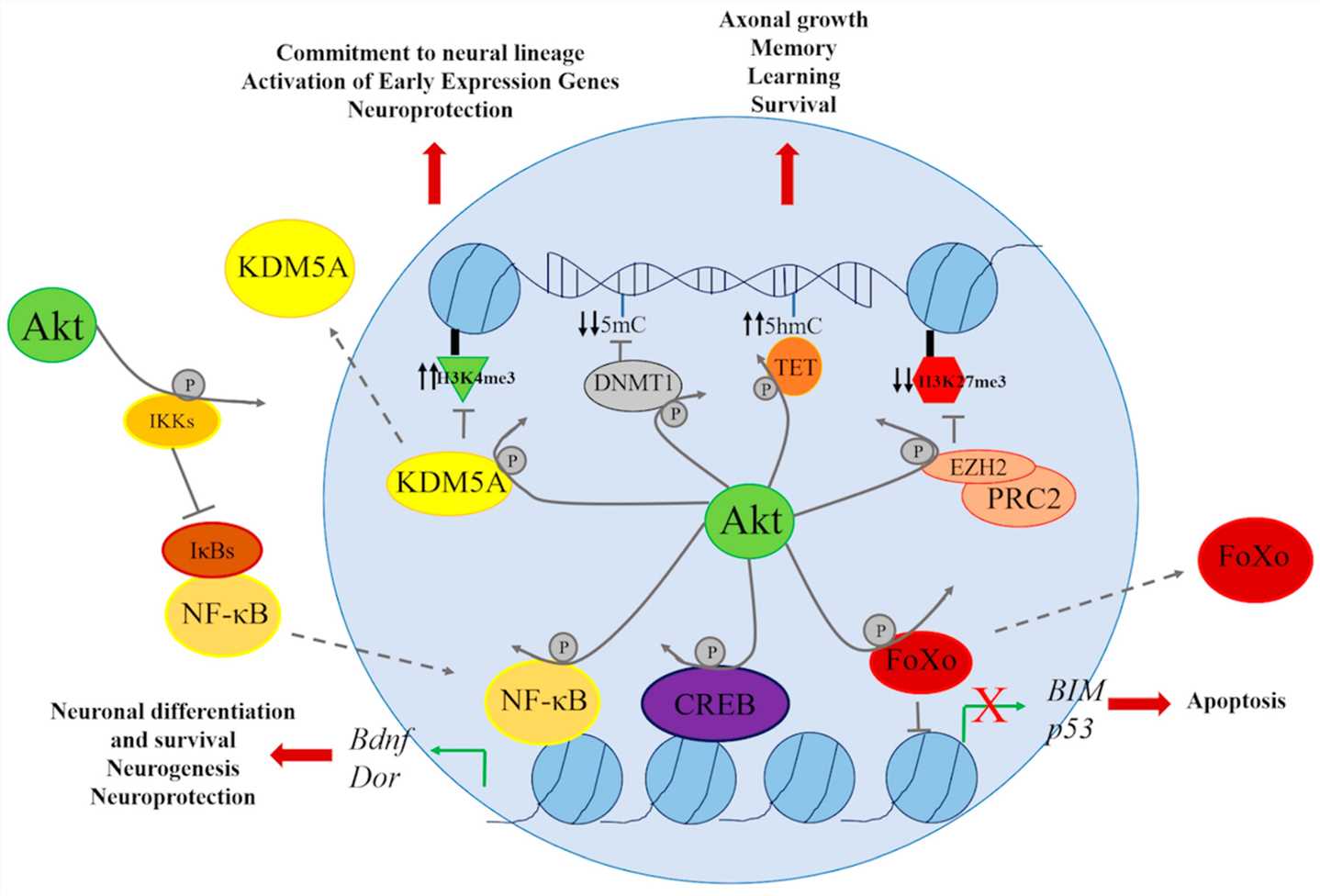Transcription Factors in the Akt Pathway
About Transcription Factors in the Akt Pathway
Transcription factors are key regulators of gene expression, playing a vital role in cellular proce
sses such as growth, differentiation, and survival. The Akt pathway, also known as the PI3K/Akt pathway, is a major signaling cascade involved in cell signaling and homeostasis.
- Forkhead Box O (FOXO) Transcription Factors
FOXO transcription factors are downstream targets of the Akt pathway and play a crucial role in cell cycle regulation, apoptosis, and oxidative stress response.
Relationship with Akt: Akt phosphorylates FOXO transcription factors, leading to their cytoplasmic retention and inhibition of their transcriptional activity.
- Nuclear Factor-kappa B (NF-κB)
NF-κB is a transcription factor involved in inflammation, immune responses, and cell survival.
Relationship with Akt: Akt activates NF-κB through phosphorylation, promoting its translocation to the nucleus and regulating the expression of genes involved in cell survival and inflammation.

- cAMP Response Element-Binding Protein (CREB)
CREB is a transcription factor that regulates gene expression in response to various stimuli, including growth factors and neurotransmitters.
Relationship with Akt: Akt-mediated phosphorylation of CREB enhances its transcriptional activity, leading to the regulation of genes involved in cell survival, neuronal plasticity, and memory formation.
- Hypoxia-Inducible Factor 1 (HIF-1)
HIF-1 is a transcription factor that plays a critical role in cellular responses to low oxygen levels (hypoxia).
Relationship with Akt: Akt activates HIF-1 through multiple mechanisms, including stabilization of the HIF-1α subunit, promoting its transactivation function, and regulating genes involved in angiogenesis, energy metabolism, and cell survival.
- Signal Transducer and Activator of Transcription 3 (STAT3)
STAT3 is a transcription factor involved in cell proliferation, survival, and immune responses.
Relationship with Akt: Akt phosphorylates STAT3, enhancing its transcriptional activity and promoting the expression of genes involved in cell survival, inflammation, and tumor progression.
The Role of Transcription Factors in the Akt Pathway
Transcription factors are proteins that regulate gene expression and play a key role in mediating the effects of the Akt pathway.
Cell Survival: The Akt pathway promotes cell survival by inhibiting apoptosis or programmed cell death. Transcription factors such as nuclear factor kappa-light-chain-enhancer of activated B cells (NF-κB) and forkhead box O (FoxO) are activated by Akt and induce the expression of anti-apoptotic genes, thereby preventing cell death.
Cell Growth and Proliferation: The Akt pathway stimulates cell growth and proliferation by promoting protein synthesis and inhibiting protein degradation. Transcription factors like c-Myc and SREBP-1c (sterol regulatory element-binding protein 1c) are activated by Akt and induce the expression of genes involved in cell cycle progression and protein synthesis.
Glucose Homeostasis: The Akt pathway is crucial for maintaining glucose homeostasis in the body. Transcription factors such as hepatic nuclear factor 4 alpha (HNF4α) and peroxisome proliferator-activated receptor gamma coactivator 1-alpha (PGC-1α) are activated by Akt and regulate the expression of genes involved in glucose metabolism and insulin sensitivity.
Angiogenesis: The Akt pathway stimulates angiogenesis, the formation of new blood vessels, which is essential for tissue growth and repair. Transcription factors like hypoxia-inducible factor 1-alpha (HIF-1α) and vascular endothelial growth factor (VEGF) are activated by Akt and promote the expression of genes involved in angiogenesis.
Mechanism of Action of Transcription Factors in the Akt Pathway
The mechanisms of action of transcription factors in the Akt pathway involve their phosphorylation and activation by Akt. Upon activation, these transcription factors translocate to the nucleus and bind to specific DNA sequences called transcriptional response elements (TREs) in the promoter regions of target genes.
This binding leads to the recruitment of other proteins and co-regulators, forming transcriptional complexes that either facilitate or inhibit gene expression. The recruited proteins and co-regulators can include chromatin remodelers, histone modifiers, and RNA polymerase, among others.
Once bound to the TREs, the transcription factors and their co-regulators can either enhance or suppress the transcription of target genes, depending on the specific interactions and signaling cues present in the cellular context. Enhancer transcription factors, such as FOXO and FOXM1, can activate gene expression by recruiting co-activators that unwind chromatin, recruit RNA polymerase, and initiate transcription.
On the other hand, suppressor transcription factors, such as GSK3β and TSC2, can repress gene expression through various mechanisms. They can recruit co-repressors that compact chromatin, inhibit RNA polymerase recruitment, and prevent transcription initiation. Additionally, suppressor transcription factors can also indirectly inhibit gene expression by promoting the degradation of co-activators or competing with enhancer transcription factors for binding to the same TREs.
Overall, the mechanisms of action of transcription factors in the Akt pathway involve their phosphorylation and activation by Akt, which leads to their translocation to the nucleus and binding to specific TREs in the promoter regions of target genes. Through their interactions with co-regulators and other transcription factors, these Akt-regulated transcription factors can modulate gene expression and contribute to various cellular processes and signaling pathways.
 Fig.2 AKT phosphorylates several transcription factors, including NF-κB, CREB, and FOXO, implicated in the transcription of genes regulating neuronal differentiation, neuroprotection, neurogenesis, and apoptosis, such as Bdnf, Dor, BIM, and p53. PI3K stimulation can also inhibit (KDM5A, DNMT1, and EHZ2) or activate (TET) chromatin-associated proteins leading to upregulation or repression of genes implicated in neural differentiation, axonal growth, memory, and learning through altering chromatin marks in histone tails of DNA modifications. (Sánchez-Alegría K, et al., 2018)
Fig.2 AKT phosphorylates several transcription factors, including NF-κB, CREB, and FOXO, implicated in the transcription of genes regulating neuronal differentiation, neuroprotection, neurogenesis, and apoptosis, such as Bdnf, Dor, BIM, and p53. PI3K stimulation can also inhibit (KDM5A, DNMT1, and EHZ2) or activate (TET) chromatin-associated proteins leading to upregulation or repression of genes implicated in neural differentiation, axonal growth, memory, and learning through altering chromatin marks in histone tails of DNA modifications. (Sánchez-Alegría K, et al., 2018)
Available Resources for Transcription Factors in the Akt Pathway
At Creative BioMart, our commitment is not limited to providing products related to transcription factors in the Akt pathway, we strive to provide researchers with the tools necessary to unlock the complexities of the Akt pathway. By offering a diverse range of high-quality products and customizable services, we aim to facilitate breakthroughs in understanding the role of transcription factors, as well as other molecules, in the regulation of this critical signaling cascade.
Below are the molecules/targets related to transcription factors in the Akt pathway, click on them for product details.
Our team of experts is dedicated to supporting your research efforts, from product selection to post-sale technical assistance. With a dedication to scientific excellence, Creative BioMart promises to be your trusted partner in advancing discovery in the Akt pathway.
Contact us today to explore how our products and customized services can advance your research on transcription factors in the Akt pathway.
Reference:
- Sánchez-Alegría K, Flores-León M, Avila-Muñoz E, Rodríguez-Corona N, Arias C. PI3K Signaling in Neurons: A Central Node for the Control of Multiple Functions. Int J Mol Sci. 2018;19(12):3725.


